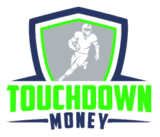We’re reader-supported. When you buy through links on our site, we may earn an affiliate commission.
Pinterest currently has 465 million monthly users, with 45% of US users having household incomes of $100,000 and up.1
Most importantly, 80% of Pinterest users have discovered new brands or products on Pinterest, meaning Pinterest is an excellent yet still untapped market for small businesses.
If you’re looking for how to make money on Pinterest, you’ve come to the right place: it’s a market of wealthier, ready-to-buy customers, and I’m going to show you how to access the market the right way!
Table of Contents
How to Make Money on Pinterest
If you want to know how to make money on Pinterest, you first have to be… you know… on Pinterest! Getting started with the right account is crucial. Here’s what you need to know.
1 – Open an Account
To get started, head to Pinterest.com and open a business account.
A Pinterest business account is similar to a personal account, but it offers features that'll help you market your business. This includes the Pinterest Business Hub and Pinterest Analytics.
Click “Sign Up” in the top-right corner and select “Create a Business Account.”
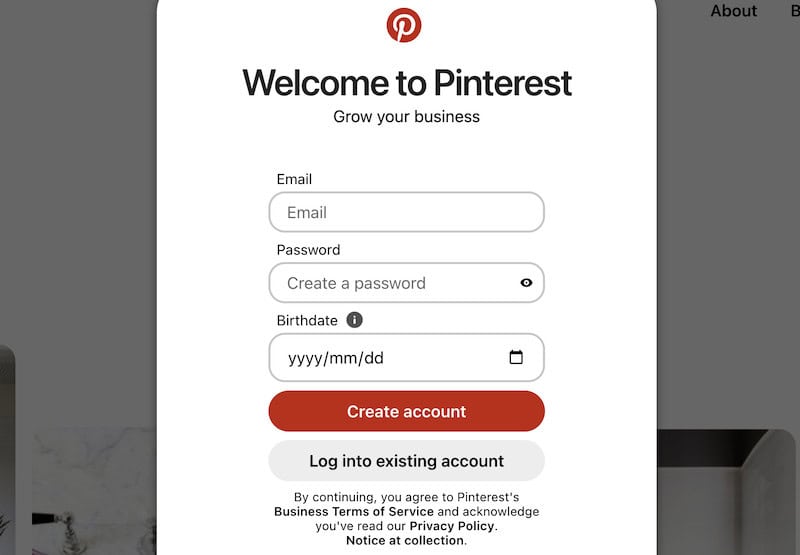
Pinterest will ask for personal details like your full name, age, and email address, and you’ll have to create a password.
Alternatively, if you already have a personal account and you want to access your personal and business account with the same email, you can create a linked business account.
To do this, log into your personal account, select the dropdown menu in the upper-right-hand corner, and click “Convert to Business.”
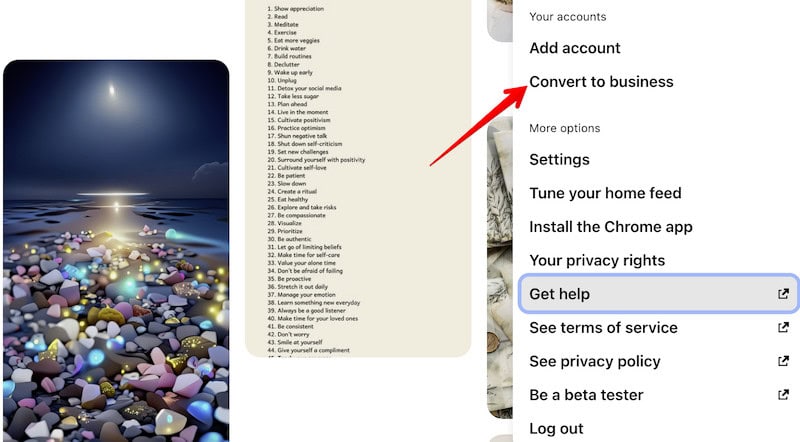
2 – Create Your Profile
Once you've created your Pinterest account, a pop-up will ask for these business details:
- Business name
- Website URL
- Country/region
- Language
- The focus of your brand
- Your business goals
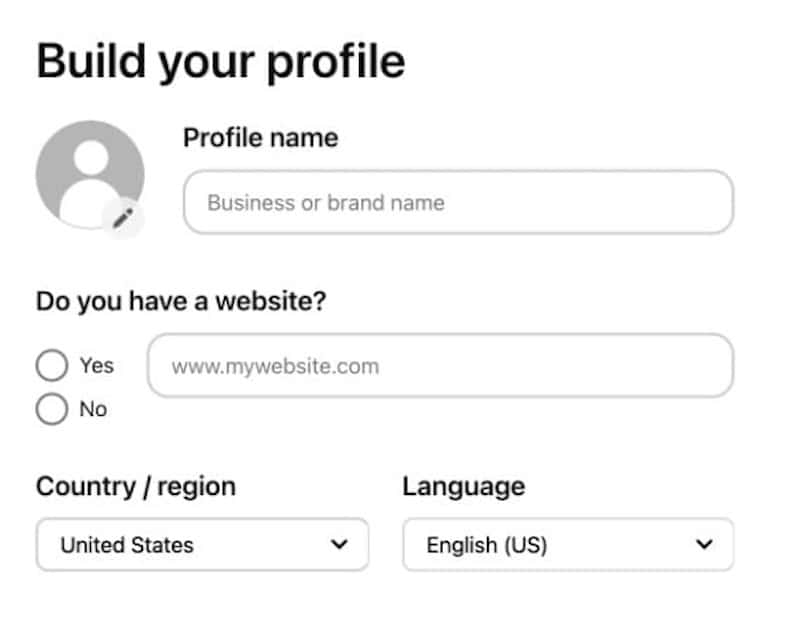
After you’ve entered these details, you can start creating ads and pins. Pinterest makes this process easy by walking you through all the steps, so you can publish content within just a few minutes.
3 – Claim Your Website
The most important thing you want to do when setting up your Pinterest profile is to claim your website.
By claiming your website/content, Pinterest will put your name next to any profile that uploads your pins. This is how you will track impressions and, in turn, the effectiveness of your Pins and ads. That’s crucial for how to make money on Pinterest – if you don’t know what’s converting people, how can you do more of it?
There are two ways you can claim your website. The first method involves navigating to the dropdown on your dashboard and clicking “Claim.”
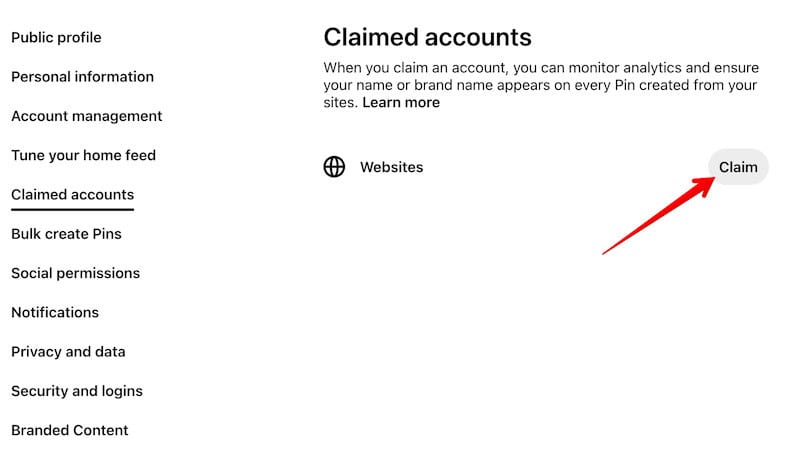
Or, if you're already using a web hosting service like Weebly, you can claim your pins inside your Weebly dashboard.
The best part is that Weebly will display your Pinterest account on your website, so when people land on your ecommerce store homepage or blog, they can view your boards and pins without visiting your Pinterest page.
Extra Point: Find out Why do you need an LLC and get your business set up properly. Get started with LLC 101 and get help choosing the best LLC service with this Bizee vs ZenBusiness comparison.
4 – Start Building Pins
Now comes the fun part, creating pins that go viral.
You can start building and uploading pins from your desktop and mobile phone. The method I’ll walk through below works for both devices.
Once logged into your Pinterest account, click “Create” in the upper left-hand corner.
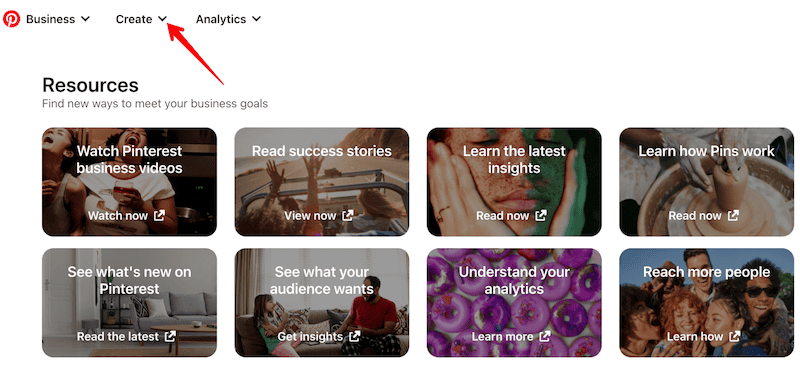
Choose between different types of pins, such as:
- Image pins
- Video pins
- Rich pins
- Collection pins
- Product pins
- Try On pins
After you've chosen a pin, Pinterest will take you to the editor.
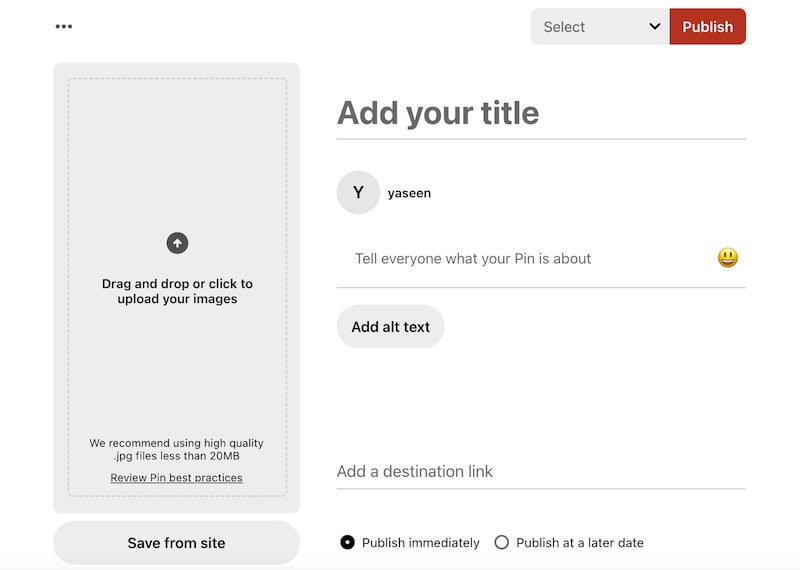
Pinterest will ask you to enter a pin title and upload an image or video from your desktop or mobile device.
Below this, add a summary telling people what your pin is about. You can also add a destination link if you want, so for example, if you own an ecommerce store and you're promoting a new product, you can paste a link to the product page here.
All that's left to do is upload your pin. You can choose to upload your pin either immediately or schedule publishing at a later date.
Tips for Making a Good Pin
So all of that is great and helpful, but… what should your Pins even look like? Would any old photo of a wombat do?
The answer, in case you’re unsure, is no! Any old photos simply will not do.
If you want to seriously learn how to make money on Pinterest, you have to engage your audience. While that may have been fine a few years ago, Pinterest users are savvier and want to know they’re not being taken to some random website.
A good Pin is brightly colored, informative, and includes a link to the blog post.
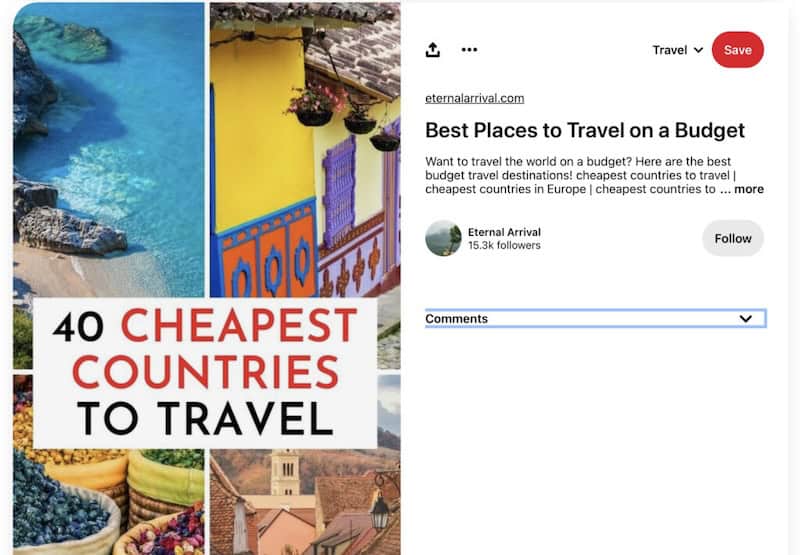
Does this pin not capture your attention? If you’re curious about traveling on a budget, you’re definitely clicking on this because it:
- Tells you what it’s about – affordable travel!
- Is engaging and eye-catching – good job with all the bright colors!
- Describes what the article will be about and provides a link to read more.
You can design images like this using programs like Canva (free and paid options) or Photoshop. With Canva, you can choose from templates that you just plug-and-play. Creating eye-catching templates doesn’t have to be hard or time consuming!
Mistakes to Avoid to Make Money on Pinterest
Because Pinterest is still a relatively untapped market, learning how to make money on Pinterest isn’t difficult. However, there are some mistakes you need to avoid if you’re serious about making money with Pinterest.
1 – Not Engaging With Followers Outside of Pinterest
Once creators start building a following on Pinterest, I find they often make the mistake of only engaging with their followers inside the platform.
Instead, you want to engage with your followers across multiple platforms as it allows for more opportunities for you to add value to their lives.
Personally, I'm a fan of using email to engage with my Pinterest followers. I normally ask them to sign up for my email newsletter in exchange for an ebook or exclusive discounts.
So if you're looking to engage with your Pinterest followers on multiple touchpoints, I highly recommend using email marketing software like ActiveCampaign to collect their email addresses and send automated email sequences to their inboxes.
2 – Sharing Products You Didn't Create
Another big mistake I see people make is sharing products they didn't create, i.e. affiliate marketing.
This is a problem because if you accidentally promote low-quality products, it’ll hurt your reputation amongst your followers.
There are three ways you can work around this problem:
- Get a 3D printer
- Teach skills you already have (check out platforms like Skillshare and Teachable)
- Open your own ecommerce store (try Shopify!)
With an initial investment as low as $100, you can buy a 3D printer and begin printing small toys and decorative items.
From here, you can sell them on your ecommerce store, link this store to your Pinterest account, and promote these products to your Pinterest followers.
- Or, if you have skills that people would like to learn (carpentry, programming, marketing), consider creating a course and promoting it on Pinterest.
You can publish courses on Skillshare and Teachable and according to these platforms, instructors earn around $0.05 to $0.10 per minute watched. So if your students watched 10,000 minutes this month, you could earn around $500 to $1,000.
The third option is to open a Shopify store, dropship products, and promote these products on your Pinterest page.
3 – Forgetting to Run Ads
By running a few dollars worth of Pinterest ads, you can market your products to thousands of people, which helps increase sales.
A mistake I see people make is sticking to the organic route, publishing pin after pin, and hoping one of these pins goes viral. While this can work, it's often a long-term strategy, and it's very rare that you're going to see significant conversions right off the bat.
Pinterest Ads can speed up this process because you can run ads to individuals with certain interests and buying patterns, helping you build traction at the beginning of your Pinterest journey.
4 – No Familiarizing Yourself With Pinterest Analytics
Pinterest offers an analytics dashboard that gives you insight into various pins' conversion rates and impressions.
With this information, you can test new things and see which ads and pins have the highest conversion rate. This is why I suggest familiarizing yourself with Pinterest Analytics as soon as possible.
On your dashboard, you'll find eight important metrics you want to track:
1. Impressions: An impression is the number of times your pins were shown to Pinterest users.
2. Saves: Also known as repinning, saves are when other users add your pin to their profile. This is a good gauge of how much value you're giving your audience because when someone repins your pin, it means they are saving it for future use.
3. Engagement: This is the best indicator of how well your pins are performing since it shows how often people have clicked on or saved your pin.
4. Total audience: The total audience metric indicates how many unique views your pins are getting, i.e., the total number of people who viewed your pins.
5. Engaged audience: On the other hand, if you want to know the total number of people who engaged with your pins (saved, clicked, commented, and reacted), the engaged audience metric can help.
6. Outbound clicks: Previously known as link clicks, outbound clicks measure how often Pinterest users have clicked the hyperlink attached to your pin. This is a good way to measure how well your call-to-actions are performing.
7. Followers-driven: The followers-driven metric shows how many users followed your profile after engaging with a specific pin. This gives you an understanding of which pins are responsible for generating followers.
8. Audience analytics: The final metric you want to get familiar with is the audience analytics metric. It measures your audience's demographics, such as their language, where they are from, and preferred Pinterest categories.
5 – Not Utilizing Pincodes
Pinterest Pincodes are like regular QR codes. Users can scan your Pincode with their mobile phone camera, and it takes them to the content of your Pincode.
But unlike regular QR codes, Pincodes give clues to the context of a pin.
As the creator, you can select an image that acts as the Pincode Lens, telling Pinterest users what your Pincode is about. All they have to do is whip out their phone, go to the camera app, scan your Pincode Lens, and it'll take them to your pin.
Retailers like Nordstrom are already using Pincodes to help bridge the gap between online and offline shopping, allowing shoppers to scroll through Pinterest boards as they shop.
And if they need more information about a specific product, shoppers can simply click on it and read through all the specs.
Common Questions About How to Make Money on Pinterest
Make Money in Pinterest?
If you own an ecommerce store or any business, you can use Pinterest to make money by generating traffic to your products. You can join the Pinterest Inclusion Fund, which’ll allow you to monetize content you post on Pinterest.2 Another option to include your own affiliate link on your pins, this way when people shop using your link, you make a commission. Read my top affiliate program reviews here:
- Zara affiliate program review
- Sephora affiliate program review
- Revolve affiliate program review
- Fashion Nova ambassador program review
- VRBO affiliate program review
- Viator affiliate program review
- Nike affiliate program review
- Chewy affiliate program
- Target affiliate program review
- Walmart affiliate program review
- Farfetch affiliate program review
How to Make Money From Pinterest?
If you already own a business, the best way to make money from Pinterest is to promote your products on the platform. If you have a website or podcast, you can also create Pins to promote your latest articles or podcast episode, driving more traffic to your website.
How Many Followers Do You Need on Pinterest to Make Money?
Although there isn’t a set number of followers you need before you start making money, most companies look to partner with influencers that have a few thousand followers. However, you can make money with even a smaller, dedicated following if they like the products or services you sell on your website.
How to Make Money on Pinterest Without a Blog?
If you don't have a blog, you can make money on Pinterest by signing up for the Pinterest Inclusion Fund. To qualify, you must be part of an underrepresented group like the LGBTQIA+ community or persons with disabilities. You can also promote your podcast or e-commerce store through Pinterest pins.
How to Make Money on Pinterest for Beginners?
The best way to make money on Pinterest as a beginner is to buy a cheap 3D printer, print small toys and decorative items, sell them on your e-commerce store, and run Pinterest ads to your store.
Related:
- LLC checklist
- Start a pet care blog
- Kit review
- Design.com review
- ClickFunnels vs Shopify
- Sellfy vs Shopify
- ClickFunnels vs Kit
- Pipeline Pro vs ClickFunnels
- Best Podcast Hosting Sites
- Best 3D Printing Software
- Best Email Marketing Software
- Best Web Hosting Services
- Low-Cost Business Ideas With High Profit
- How to Make $800 Fast
- How to Make $400 Fast
- How to Make Money as a Video Editor
Sources:
1 – https://business.pinterest.com/audience/
2 – https://creators.pinterest.com/creator-inclusion-fund/?utm_source=Help_Center
